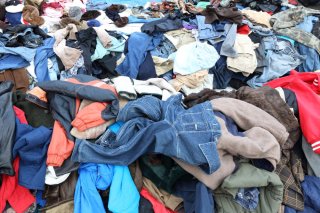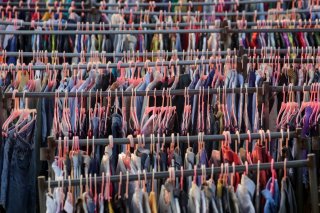Fashion Forward: Fabric Recycling and Reuse this Spring
One thing that many EPA employees are passionate about is the environment – even when we are off the clock. While EPA has experts of all kinds, you don’t have to be an ecotoxicologist or microplastic pollutant expert to be an environmentalist.
Meet EPA's Green Team
At EPA headquarters, we have a volunteer group called “Green Team” where employees come together to discuss environmental topics outside of our day jobs – green projects we are passionate about that align with our environmental values. Recently, one of our discussions led us to the topic of fabric waste in the U.S. After some discussion and research, the Green Team created an internal fabric recycling guide centered around reduction, reuse, and recycling of clothing. Though we initially thought the effort would be lighthearted, we came across serious themes that left a lasting impression on us.
Climate Impacts of the Fashion Industry

Our first distressing realization was that globally, the fashion industry is so resource-intensive that it rivals the aviation industry in terms of global carbon emissions. We also learned that fabric production has an enormous footprint in other ways – for example, cotton production in the U.S. alone uses millions of pounds of pesticides on a yearly basis. Additionally, transforming raw materials such as cotton into clothing like jeans or a t-shirt involves “wet processing”- water-intensive tasks like bleaching, dying, and printing, all of which produce tremendous amounts of wastewater and can result in devastating pollution to local waterways.
Synthetic materials like polyester can also have troublesome impacts, and often our clothing is made from petroleum derivatives. We were alarmed by how much microplastic shedding occurs; loose-knit synthetic textiles like polyester “fleece” are some of the worst offenders. A recent report from International Conservation of Nature estimates that 35% of ocean microplastics come from the laundering of synthetic textiles.
But wait, we (and probably you) thought: the saving grace here is that fabric gets recycled when I bring it to the thrift store or consign it, right? Well, not exactly.
The Challenges of Fabric Reuse and Recycling
We realized that ‘reuse’ and ‘recycling’ are two very different things. Yes, if the thrift store deems your item fit for resale, they might be able to sell it to someone else to wear (reuse). But what about the items deemed unfit for resale or clothing that does not leave the racks? These items are very unlikely to be taken apart and reprocessed into new useful products (recycle).
According to a 2016 Newsweek report, only 0.1% of all clothing collected by charities and take-back programs are recycled.
The difficulty of fabric recycling mirrors the difficulty of plastic recycling – rates are low because of the high cost, limits of material reuse, and low demand. Like a granola bar wrapper that has both plastic and metal components, when you donate or discard a blended fabric, the ingredients are difficult to separate and extract for recycling. Instead, in the U.S., 14.5 million tons of textiles were landfilled and incinerated in 2018 – clothing being the main source. So, we realized that while donating and consigning may give clothing a chance of staying out of a landfill temporarily, it doesn’t justify more shopping and it isn’t a long-term solution.
How You Can Make an Impact

At this point, it’s easy to be overwhelmed with climate and waste reduction anxiety and a feeling of “But, what can I really do to help?”. Some of us may already enjoy rotating clothing, our bodies – or the seasons - change, or clothing gets worn out and needs to be replaced. Our Green Team members considered this and decided to borrow from EPA’s waste management hierarchy: Refuse, Reduce, Reuse, and Recycle (or in just a few words, buy less and buy better clothing!).
What do these terms mean? Refuse is the practice of saying no to adding items to your cart or closet and abstaining from consumerism when possible. To ‘refuse’, you could establish a buy-nothing practice and see how long you can keep it up. To reduce is to think of the item’s versatility and functionality in your lifestyle and only buy the minimum needed. You can also avoid washing clothes after each use, which will lengthen clothing items’ lifespans. To reuse is contribute to and use the U.S.’s fantastic, thriving secondhand market online or visit brick-and-mortar consignment shops and thrift stores. Find ways to upcycle (making something new or more useful out of something you would otherwise toss in the trash) by making quilts or gift-wrapping using fabric scraps. Recycle is the last of the four R options because at this time, like plastics, there is no guarantee your clothing will actually be recycled. Nevertheless, it’s still worth it to seek out innovative private companies who recycle fabric, or find public programs, such as animal shelters, who might have uses for old clothing or fabric scraps.
During your spring cleaning this year, EPA’s Green Team hopes you will consider the four Rs and contemplate the impact your shopping habits have on the environment. We know, after learning so much about impacts of the fashion industry, we will!
About the Author
ELN Green Team
Emerging Leaders Network (ELN)
Green Team
The Emerging Leaders Network (ELN) Green Team is a non-labor employee group that helps to minimize the environmental footprint of EPA headquarters offices and operations. Our focus areas range from establishing and maintaining composting in the EPA kitchens to getting together to remove invasive plants at local parks on the weekend.
Editor’s Note: The views expressed here are intended to explain EPA policy. They do not change anyone’s rights or obligations. You may share this article. However, please do not change the title or the content, or remove EPA’s identity as the author. If you do make substantive changes, please do not attribute the edited title or content to EPA or the author.
EPA’s official web site is www.epa.gov. Some links on this page may redirect users from the EPA website to specific content on a non-EPA, third-party site. In doing so, EPA is directing you only to the specific content referenced at the time of publication, not to any other content that may appear on the same webpage or elsewhere on the third-party site, or be added at a later date.
EPA is providing this link for informational purposes only. EPA cannot attest to the accuracy of non-EPA information provided by any third-party sites or any other linked site. EPA does not endorse any non-government websites, companies, internet applications or any policies or information expressed therein.
